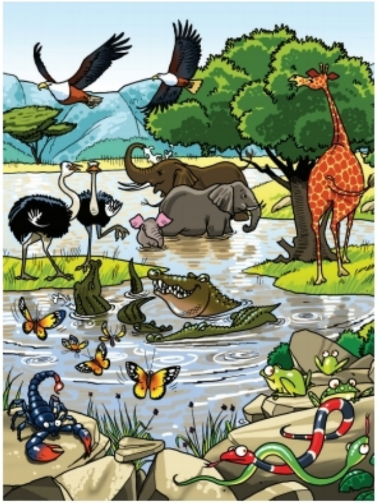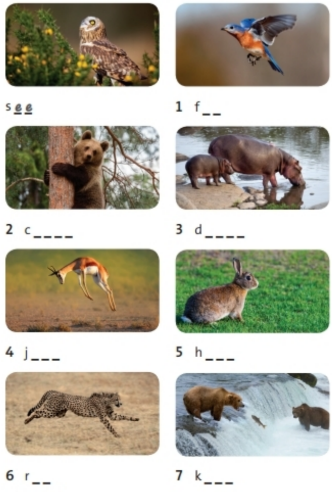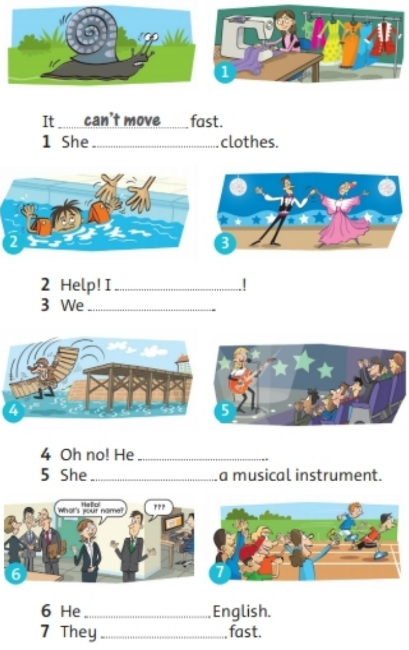Giải SGK, SBT Unit 3. Wild life Friends Plus
Giải SGK, SBT Unit 3. Wild life Friends Plus
Exercise 2. Watch or listen again and complete the Key Phrases.
(Xem hoặc nghe lại và hoàn thành Key Phrases.)
|
KEY PHRASES |
|
Identifying things 1. What do you think …………………? 2. …………………... no idea. 3. It looks like a /an.. ………………… . 4. It sounds like a / an...…………………. . 5. Maybe it's a / an..…………………? |
Exercise 4. Play the Creature close-ups game. Follow the instructions. Then listen and check.
(Chơi trò chơi Cận cảnh sinh vật. Làm theo các hướng dẫn. Sau đó nghe và kiểm tra.)

|
ostrich butterfly frog bear snake bat eagle gorilla panda whale rat crocodile octopus fish elephant rabbit |
Creature close-ups
• How many animals can you name?
• Work in teams.
• Take turns identifying the animals. Use animal names in the box in exercise 4.
Use the Key Phrases.
Exercise 1. Write the superlative form of the adjectives in the table.
(Viết dạng so sánh nhất của tính từ trong bảng.)
|
Short adjectives |
|||
|
Regular End in –e End in consonant + y End in consonant + vowel + consonant |
Adjective dull, weird, slow rare, safe ugly, pretty big, hot |
Superlative the dullest …………… , .…………… …………… , .…………… …………… , .…………… …………… , .…………… |
|
|
Long adjectives |
|||
|
Adjective colourful common expensive |
Superlative the most colourful …………… …………… |
||
|
Irregular |
|||
|
Adjective bad good far |
Superlative the worst …………… the furthest/ the farthest |
||
Exercise 3. Read the Study Strategy. Then write five sentences with your ideas. Use the adjectives and the topics in the boxes. Compare with a partner.
(Đọc Chiến thuật học tập. Sau đó viết 5 câu với ý tưởng của em. Sử dụng các tính từ và các chủ đề trong khung. So sánh với bạn của em.)
|
STUDY STRATEGY |
|
Improving your grammar Inventing sentences is a good way to remember grammar rules and improve your grammar. |
|
good bad boring pretty nice horrible |
|
film star animal team friend place food |
- I think the best football team is Arsenal.
(Tôi nghĩ đội bóng giỏi nhất là Arsenal.)
- In my opinion, the most horrible animals are spiders.
(Theo tôi, loài vật đáng sợ nhất là nhện.)
Exercise 1. Check the meanings of the verbs in the box. Look at the quiz and complete the questions with eight of the verbs. Listen and check your answers.
(Kiểm tra nghĩa của các động từ trong khung. Nhìn câu đố và hoàn thành các câu hỏi với 8 động từ. Nghe và kiểm tra câu trả lời của em.)
|
swim drink hear communicate fly jump survive kill climb grow move run see (x2) |
Animal skills quiz
Some animals are fast, some are big and strong. Some are intelligent, some are dangerous. What do you know about animals and their skills?
1. Can elephants (1)..................... with their ears and their feet?
a. Yes, they can.
b. No, they can't
c. Some can and some can't.
2. How big can a gorilla? (2).....................
a. 150 kilos.
b. 200 kilos.
c. 250 kilos.
3. Some scorpions are dangerous. Can a scorpion (3)..................... a human?
a. Yes, it can.
b. No, it can't.
c. Some can and some can't.
4. Camels don't (4)..................... a lot of water. How many months can a camel (5)..................... without water?
a. Three months.
b. Six months.
c. Nine months.
5. How far can an eagle (6).....................? It can (7)..................... a small animal from a distance of
a. 500 metres.
b. one kilometre.
c. more than one kilometre.
6. Ostriches can't (8)..................... but how fast can they (9).....................?
a. Six kilometres an hour.
b. Sixteen kilometres an hour.
c. Sixty-five kilometres an hour.
Exercise 4. Read the Skills Strategy and listen again. What two extra pieces of information do you hear? Choose from a-d.
(Đọc Chiến thuật và nghe lại. Hai thông tin bổ sung mà em nghe được là gì? Chọn a-d.)
|
SKILLS STRATEGY |
|
How to do the listening quiz: • First, read all the questions and options. • Next, predict the general meaning of the text. • Then, focus on the detail you need and then choose the correct option. |
a. Scorpions are intelligent.
b. Some of the smallest scorpions are the most dangerous.
c. Ostriches are the heaviest, fastest, and tallest birds.
d. Some monkeys can speak.
Exercise 1. Complete the examples from the quiz on page 42. Then choose the correct answers in Rules 1-4.
(Hoàn thành các ví dụ từ câu hỏi trang 42. Sau đó chọn câu trả đúng trong Quy tắc 1-4.)
An eagle (1)………….. see a small animal from a great distance.
Ostriches (2)………….. fly.
(3)………….. a scorpion kill a human? Yes, it (4)………….../ No, it (5)…………...
(6)………….. elephants hear with their ears and their feet? Yes, they (7)………….. / No, they (8)………….. .
|
RULES |
|
1. We use can/can't in affirmative sentences. 2. We use can / can't in negative sentences. 3. We use do and does / can and can't in questions and short answers. 4. The he/she/it forms of can are different / the same. |
might (có thể)
Exercise 3. Look at the examples of sentences with might. Then choose the correct answers in the Rules.
(Nhìn các câu ví dụ với might. Sau đó chọn câu trả lời đúng trong Quy tắc.)
Be careful, it's a scorpion. It might be dangerous.
(Cẩn thận, nó là bọ cạp đó. Nó có thể nguy hiểm.)
We might see a bear in the national park.
(Chúng ta có thể nhìn thấy con gấu trong công viên quốc gia.)
|
RULES |
|
We use might when we know / don't know if something is true. The he/she/it forms of might are different / the same. |
Questions with How…?
(Câu hỏi với How…?)
Exercise 4. Complete the quiz questions with the words in the box. Then listen and check.
(Hoàn thành các câu đố vui với các từ trong khung. Sau đó nghe và kiểm tra.)
|
far long tall heavy fast many |
... is a new baby?
How heavy is a new baby? (Em bé mới sinh nặng bao nhiêu kg?)
1. ... can the fastest person run?
2. ... countries are there in the world?
3. ... is an adult giraffe?
4. ... is an adult crocodile?
5. ... is the North Pole from the South Pole?
Exercise 5. Look at the Key Phrases. Answer the questions in exercise 4 with the information in the box. Use the Key Phrases. Then compare with a partner.
(Nhìn Key Phrases. Trả lời các câu hỏi ở bài tập 4 với thông tin trong khung. Sử dụng Key Phrases. Sau đó so sánh với bạn của em.)
|
KEY PHRASES |
|
Estimating A new baby is usually between 2.5 and 4.5 kilos. Gorillas can grow to around 250 kilos. Camels can survive about six months without water. |
Exercise 6. USE IT! Ask and answer questions with How…?. Find people in the class with the same answers as yours.
(Thực hành! Hỏi và trả lời những câu hỏi với How…?. Tìm trong lớp người có câu trả lời giống em.)
|
How far…? How tall…? How fast…? How many…? |
- How far can you swim? (Bạn có thể bơi bao xa?)
- I can swim about 100 metres. (Tôi có thể bơi khoảng 100m.)
Exercise 2. Watch or listen and complete the dialogue with the phrases in the box. Check your answer to exercise 1. When can Lottie watch the TV programme?
(Xem hoặc nghe và hoàn thành bài hội thoại với các cụm từ trong khung. Kiểm tra câu trả lời của em ở bài tập 1. Khi nào Lottie có thể xem chương trình truyền hình này?)
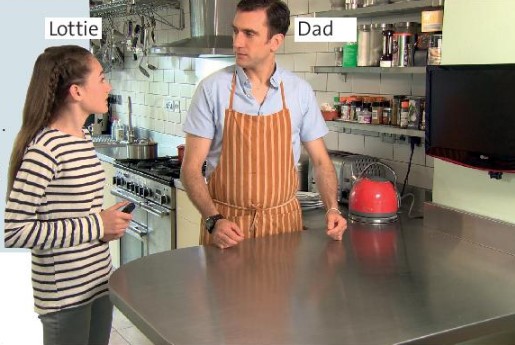
|
It's really good watch TV later watch that wildlife programme on TV it's time for dinner |
Lottie: Dad.
Dad: Yes?
Lottie: Is it OK if I (1)……………….. ?
Dad: No, I'm afraid you can't.
Lottie: But Dad, why not? (2)……………….. .
Dad: I'm sorry, but (3)……………….. .
Lottie: Oh, OK. Can I (4)……………….., then?
Dad: Yes, of course you can.
Lottie: Great. Thanks, Dad.
Exercise 4. Match a-f with 1-3 in the Key Phrases. There is more than one correct answer.
(Nối a-f với 1-3 trong Key Phrases. Có nhiều hơn 1 câu trả lời đúng.)
a. you're always on the computer
b. watch TV
c. it's late and you've got school tomorrow
d. go to a friend's house
e. use the computer
f. you need to help with the housework now
|
KEY PHRASES |
|
Requesting permission 1. Is it OK if I/ we……………… ? 2. Can I/ we/ you……………….? Giving permission Yes, of course you can. Refusing permission No, I’m afraid you can’t. 3. I’m sorry, but…………….. . |
Exercise 6. Work in pairs. Look at the situation. Prepare and practise a new dialogue. Use the dialogue in Exercise 2 and the Key Phrases.
(Làm việc theo cặp. Xem tình huống. Chuẩn bị và thực hành bài hội thoại mới. Sử dụng bài hội thoại ở bài tập 2 và Key Phrases.)
|
You want to use the computer in your classroom. Ask your teacher for permission. (Em muốn sử dụng máy vi tính trong lớp học. Hỏi giáo viên để xin phép.) |
1. Check the meanings of the words in the box. Which of these do you think is a problem for the Philippine eagle? Read the information leaflet and check.
(Kiểm tra nghĩa của các từ trong khung. Bạn nghĩ cái nào là vấn đề của đại bàng Phi-lip-pin? Đọc thông tin trên tờ rơi và kiểm tra.)
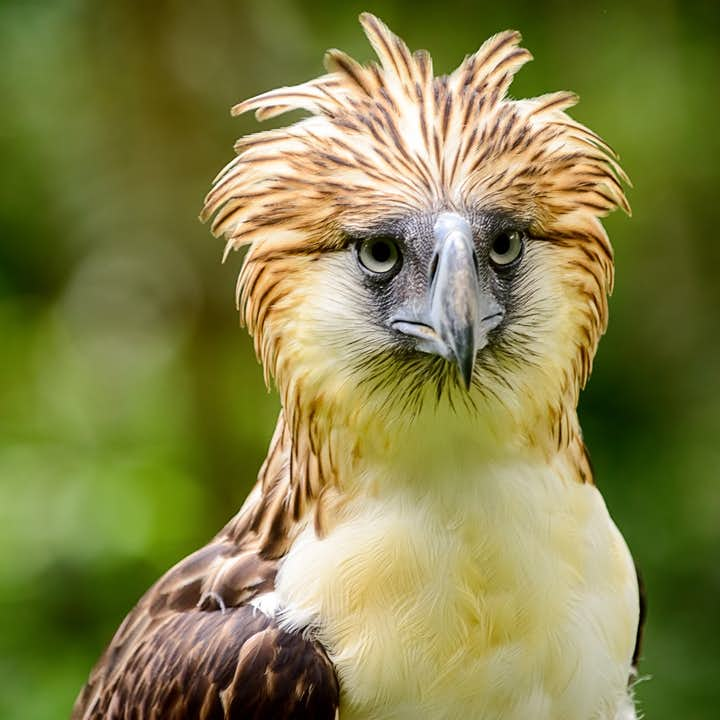
|
farming pollution hunting fishing |
LET'S PROTECT…The Philippine eagle
The Philippine eagle lives in the forests of the Philippines. Adult birds can be one metre long and weigh eight kilos. It eats small animals such as snakes, bats, and rats. It's in danger now and it's rare. The biggest problem is human activity like farming. You can find information on the website of the Philippine Eagle Foundation. It explains how to protect the eagle. For example, it's possible to 'adopt' an eagle.
3. Complete the Key Phrases with words from the text.
(Hoàn thành Key Phrases với các từ trong văn bản.)
|
KEY PHRASES |
|
Describing animals in danger 1. They can weigh/ grow to/ be…………… . 2. It eats……………….such as…………... . 3. It’s……………………. now. 4. You can find information…………………. . |
6. USE IT! Follow the steps in the writing guide.
(Thực hành! Làm theo các bước ở phần hướng dẫn viết.)
|
WRITING GUIDE |
|
A. TASK Find information about the Galapagos penguin or an animal in danger in Việt Nam. Write an information leaflet about it. B. THINK AND PLAN 1. Where does it live? What does it eat? 2. How rare is the animal? 3. Why is it in danger? 4. Where can we find information about it? 5. How can we help to protect it? C. WRITE Note: Write only ONE paragraph. The ... lives... . The biggest problem is ... . It can ... and ... . You can find ... . It eats... . For example, ... . It is in... . D. CHECK • superlative forms • giving examples • can / can't |
Exercise 1. Check the meanings of the words in the box and match them with pictures 1-9. Then complete the text with the correct words.
(Kiểm tra nghĩa của các từ trong khung và nối chúng với bức tranh 1-9. Sau đó hoàn thành văn bản với các từ đúng.)
|
feathers scales legs hair wings lungs fins backbones gills |

|
Vertebrates Vertebrates are animals with backbones. The following groups are the different types of vertebrates. |
|
Fish Fish are cold blooded animals and they live in water. They have got scales and (1)………… . They haven't got lungs. They have got (2)………… instead. |
|
Mammals All mammals are warm-blooded and they feed their babies milk. Most mammals live on land, for example, humans and dogs. However, some mammals, like whales, live in water, but they haven't got gills. Mammals have all got (3)………… . |
|
Birds Birds live on land, but some of them look for food in the water. They have got (4)………… , two legs and two (5)………… . Some birds, like ostriches and kiwis, can't fly. All birds lay eggs. |
|
Amphibians When amphibians are young, they live in water and they haven't got lungs. When they are adult, they have got lungs and four (6)………… - for example, frogs and toads. |
|
Reptiles Most reptiles live on land. They have got lungs and (7)………… but not gills. They haven't got any wings or feathers and they haven't got any (8)………… . They are cold blooded animals and many of them live in warm places. |
Exercise 4. Which group are these animals from? Use the information to classify them.
( Những động vật này thuộc nhóm nào? Sử dụng thông tin sau để phân loại chúng.)
|
crocodile shark camel eagle |
|
1 |
Does it feed its babies milk? |
|
|
Yes. It's a mammal. |
No. Go to number 2. |
|
|
2 |
Has it got feathers and wings? |
|
|
Yes. It's a bird. |
No. Go to number 3. |
|
|
3 |
Has it got fins? |
|
|
Yes. It's a fish. |
No. Go to number 4. |
|
|
4 |
Has it got scales? |
|
|
Yes. It's a reptile. |
No. It's an amphibian. |
|
Exercise 3. STAND IN ORDER. Work in groups. Each student chooses an animal from page 38. Write your animal on a piece of paper. Look at the adjectives in the box. One person says a superlative, for example, 'the fastest!'. Stand in order, with the fastest animal on the left. Then repeat the activity with a different adjective.
(ĐỨNG THEO THỨ TỰ. Làm việc nhóm. Mỗi học sinh chọn một con vật từ trang 38. Viết con vật của bạn trên một mảnh giấy. Nhìn vào các tính từ trong khung. Một người nói câu so sánh nhất, chẳng hạn, 'nhanh nhất!'. Đứng theo thứ tự, với con vật nhanh nhất ở bên trái. Sau đó lặp lại hoạt động với một tính từ khác.)
|
big fast dangerous heavy intelligent rare pretty ugly |
The fastest!: CAT, OSTRICH, BEARS, FISH
(Nhanh nhất: mèo, đà điểu, gấu, cá)

Exercise 5. WHAT AM I? Work in pairs. Put the words in order to make sentences. Can you guess the animals?
(Tôi là ai? Làm việc theo cặp. Đặt các từ theo thứ tự để tạo thành câu. Em có thể đoán các động vật này không?)
|
1 1. legs / eight/ got / I've. 2. quite / big / I'm. 3. 1/ swim / can. What am I? |
2 1. a/from / I'm/bird / Africa / large 2. run/can/ I /fast. 3. can't/fly/I. What am I? |
3 1. dangerous / a /very / I'm/animal. 2. got/big/ I've / mouth/ very/a. 3. green/ and / long / I'm. What am I? |
Exercise 6. ASK ME A QUESTION! Work in pairs. Follow the instructions.
(Hãy hỏi tôi một câu hỏi! Làm việc theo cặp. Làm theo các hướng dẫn.)
• One of you is Student A and the other is Student B.
• Toss a coin. If the coin lands on 'heads', Student A asks a question. If the coin lands on 'tails', Student B asks a question. Use the words in the box for the questions. The first student to ask five questions is the winner.
|
How far ...? How tall... ? How fast ...? How many ... ? |
3. Read the clues and write the animals.
(Đọc các gợi ý và viết các con vật.)
|
camel elephant giraffe octopus panda scorpion spider |
|
GUESS THE ANIMALS! It lives in China. It's black and white. It eats for more than twelve hours every day! panda It lives in Africa. It's yellow and brown. It's very tall - usually five metres or more! (1)_____ It has got eight arms. It lives in the water. When it goes to a different place, it sometimes changes colour.(2)_____ It often lives in a hot place. It sometimes goes without water for six months! (3)_____ It's small and it usually lives in hot places. It has got a very dangerous tail. (4)_____ It has got very big ears and a long nose. It sometimes lives for seventy years! (5)_____ It has got eight legs. It often eats a lot of insects in one day. (6)_____ |
3. Read the clues and write the animals.
(Đọc các gợi ý và viết các con vật.)
|
camel elephant giraffe octopus panda scorpion spider |
|
GUESS THE ANIMALS! It lives in China. It's black and white. It eats for more than twelve hours every day! panda It lives in Africa. It's yellow and brown. It's very tall - usually five metres or more! (1)_____ It has got eight arms. It lives in the water. When it goes to a different place, it sometimes changes colour.(2)_____ It often lives in a hot place. It sometimes goes without water for six months! (3)_____ It's small and it usually lives in hot places. It has got a very dangerous tail. (4)_____ It has got very big ears and a long nose. It sometimes lives for seventy years! (5)_____ It has got eight legs. It often eats a lot of insects in one day. (6)_____ |
5. Complete the dialogues with the given words.
(Hoàn thành các đoạn hội thoại với các từ đã cho.)
|
beautiful colourful common dull rare |
“Those small birds are very pretty.” - “Yes. They're really beautiful.”
(Những con chim nhỏ rất xinh đẹp. - Đúng. Chúng thực sự rất đẹp.)
1. “My favourite type of butterfly is red, green and yellow.” - “It's very _____." “Yes”
2. “How many of these animals are there in the world?” - “Only twenty! They're very ____.”
3. “What colour are wild rabbits?” - “They are _____ brown. They aren't very colourful animals.”
4. “Are there a lot of bats in your area ?” - “No, they aren't very ____.”
3. Read the notes. Then complete the text.
(Đọc ghi chú. Sau đó hoàn thành văn bản.)
|
What are servals? African wild cats Where do they live? countries like Africa/ Tanzania How big are they? one metre long taller than most cats How heavy are they? eighteen kilos How fast can they run? eighty likometres an hour What do servals eat? Rats, frogs, snakes can jump and kill birds Are servals in danger? Yes, in some places-smaller numbers. Problem - hunting |
Size: Servals can be (3)____ long. They have long legs and they are one of the (4)_____ animals in the cat family. Some servals can weigh (5)_____Servals are African wild cats. They live in different countries in Africa such as (1)____ and (2)_____.
Speed: Servals are fast animals. They can run at (6)_____
Food: Servals eat animals like rats, and other small creatures such as (7)_____ and (8)_____. They (9)_____ up to three metres and (10)_____ birds too!
Problems: In some parts of Africa there are now (11)_____ of servals and they are in danger. The biggest problem is human activity like (12)_____
CÁC BÀI TẬP KHÁC






